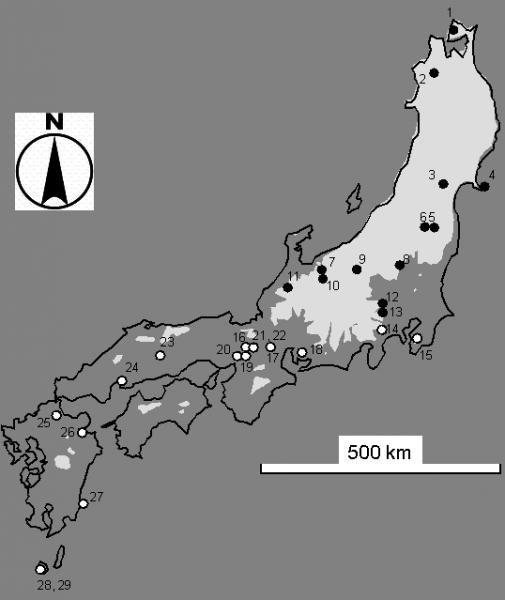



|
TOPICS BONOBO Chimpanzee "Ai" Crania photos Itani Jun'ichiro archives Open datasets for behavioral analysis Guidelines for Care and Use of Nonhuman Primates(pdf) Study material catalogue/database Guideline for field research of non-human primates 2019(pdf) Primate Genome DB 
Primate Research Institute, Kyoto University Copyright (c) |
Japanese Spatial patterns in the diet of the Japanese macaque, Macaca
fuscata, and their environmental determinants
Tsuji Y., Ito T.Y., Wada K., and Watanabe K.
Abstract
We aimed to ascertain the environmental determinants of the diets of Japanese macaques (Macaca fuscata) in relation to geographical (latitude and elevation) and environmental variables (annual rainfall, mean temperature, snow characteristics, and normalized difference vegetation index NDVI, a proxy of the primary productivity). We collected dietary data for the entire range of Japanese macaques (29 study sites), and extracted each dietary component to determine spatial patterns over the species range and between forest types. We then conducted model selection to identify the environmental determinants of the staple diets and dietary diversity. Japanese macaque diets were mainly composed of (1) foliage, (2) fruits and seeds, and (3) bark and buds throughout the entire range. Percentages of bark and buds were greater in deciduous forests than in evergreen forests, whereas other significant differences in the proportions of the other two major components and dietary diversity were not observed in different forest types. Macaques inhabiting forests with higher NDVI and with less snow fed more on fruits and seeds, and a high dietary diversity was observed. In snowy forests, macaques inhabiting higher elevation fed more on foliage, whilst those inhabiting lower elevations fed mainly on bark and buds. When studying spatial patterns in the feeding behaviour of mammals, both environmental and geographical variables should be treated equally since the former„ŗ—‘ effect is sometimes independent of the latter„ŗ—‘. In addition, more emphasis should be placed on snow characteristics because snow decreases availability of terrestrial food items and increases energy costs (in terms of locomotion and body temperature regulation), which can affect feeding behaviour and dietary diversity. 
Bibliographic information
Mammal Review DOI: 10.1111/mam.12045 2015/09/17 Primate Research Institute
|